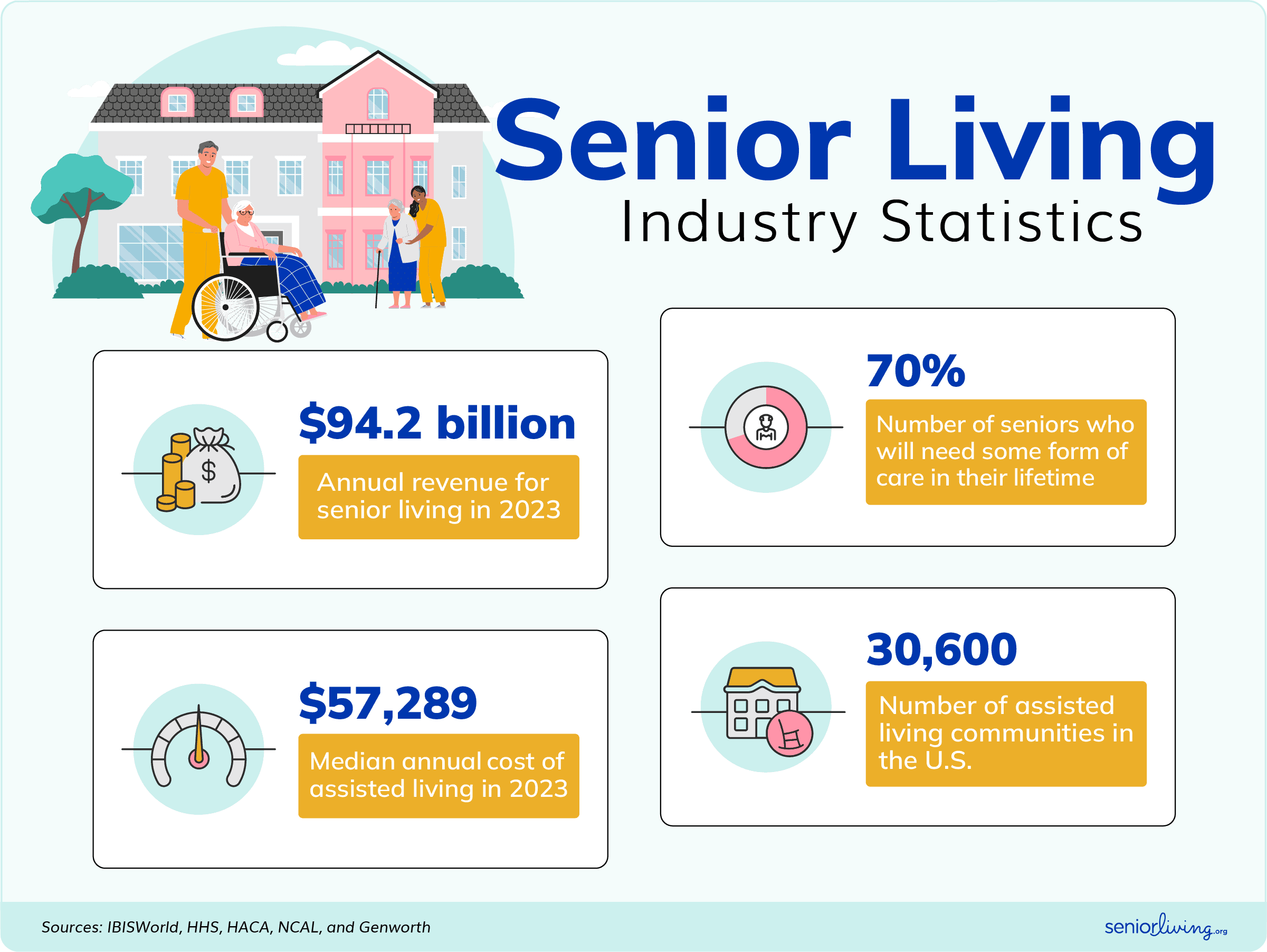Senior-Living Industry Statistics
SeniorLiving.org is supported by commissions from providers listed on our site. Read our Editorial Guidelines
Find Senior Living Near You
Join 1,019,247 Seniors Who've Searched for Housing Communities on SeniorLiving.org.
Find Senior Living Near You
Senior-Living Industry Statistics: Key Takeaways
- The senior-living industry generally encompasses home care, temporary facility care, and long-term housing and assistance for older adults.
- Assisted living is the most common type of senior living for adults over the age of 75.1
- The market share of senior-living businesses is expected to grow by 4 percent annually over the next decade.
- The senior-living industry currently brings in revenue exceeding $94 billion each year.
The senior living industry is vast, and it continues to grow each year, with annual revenue increasing from $78.2 billion in 2016 to $94.2 billion in 2023.2 Part of that growth can be attributed to increased investments in retirement communities and other senior housing options. Much of it has simply stemmed from shifting demographics in the United States. As of the 2020 census, one in six Americans is over the age of 653, and many of them will move to a senior living community at some point during their retirement.
In this guide, we’ll take a closer look at the state of the senior living industry and provide some of the most important facts and statistics.
Senior Living Industry Statistics at a Glance
Since senior living encompasses a wide range of companies, facilities, and services, it’s important to look at how the industry has developed in various respects in recent years. Staying informed about the latest trends in senior living can help guide you to make better decisions for yourself or a loved one.
Types of Senior Living
Roughly 9.5 million U.S. seniors live in a long-term or post-acute care facility for some length of time each year.3 Below are some of the most common types of senior living in the United States.
Independent Living
- These are 55-plus retirement communities designed for older adults who require no help with activities of daily living.
- Section 202 helps low-income independent or disabled seniors access affordable housing through government subsidies.5
- The number of independent living communities increased by 1.2 percent between 2022 and 2023.6
Home Health Care
- Home health care allows older adults to continue living in their homes while receiving care from a licensed nurse or home health aide.
- 65 percent of older adults require home health care for an average of two years.7
- Services provided through a home health care agency vary from custodial support to palliative care.
Assisted Living
- Assisted living facilities and residential care communities provide housing and assistive services for adults who need help with at least two activities of daily living.
- There are approximately 30,600 assisted living facilities in the United States, with 1.2 million licensed beds.8
- More than 40 percent of assisted living facilities are located in the western United States.9
Service-Enriched Housing
- Service-enriched housing is permanent rental housing combined with supportive services, often subsidized by government agencies or nonprofit organizations.
- Availability and eligibility requirements vary from state to state.
- All service-enriched housing programs must offer a housing unit with affordable rent levels and a supportive services program or service coordinator.10
Continuing Care Retirement Community (CCRC)
- Continuing care retirement communities offer multiple levels of care that can be accessed as your health status and individual needs change.
- There are more than 1,900 CCRCs in the United States.11
- Approximately 43 percent of employees at CCRCs fall under the umbrella of health care support occupations, which includes Certified Nursing Assistants, patient care assistants, orderlies, and home health care aides.13
Nursing Home
- Nursing homes are facilities for older adults who require greater levels of care and round-the-clock supervision.
- There are more than 15,300 nursing homes in the United States, with 1.6 million licensed beds.14
- Many nursing homes are licensed to function as both skilled nursing facilities and long-term care facilities.15
Costs
Senior living costs vary widely based on the type of housing, level of care, and location. Based on nationwide data from Genworth,16 below are the estimated median annual costs for the most common types of senior living and care in 2024.
- Home health aide: $77,769
- Assisted living facility: $66,126
- Nursing home (private room): $120,304
- Nursing home (semi-private room): $107,146
- Adult day care: $25,441
Pro Tip: A long-term care insurance policy could help you pay for assisted living or even home health care.
It’s important to consider that these are estimates for certain senior living options. Living at home or moving into an independent living community could cost substantially less than assisted living or a similar arrangement that provides care from a trained professional.
Nationwide Availability
Depending on your location, you may not have easy access to a retirement community or care facility for older adults. In many cases, where you live can be even more important than amenities and cost. Below are a few important statistics to think about when looking for senior living options in your area.
- According to the National Center for Assisted Living, assisted living facilities are most common in the western United States — particularly California — but every state and region has assisted living options.
- 8.6 percent are in the Northeast
- 22.6 percent are in the Midwest
- 28.0 percent are in the South
- 40.8 percent are in the West
- There are more than 30,500 residential care communities with nearly 1.2 million licensed beds in the United States.17
- Senior housing and care properties across the country saw an increase in average occupancy rates from 83.1 percent in Q1 of 2023 to 83.7 percent in Q2 of 2023.18
Resident Demographics
Most retirement communities are for people 55 or older, but some communities accept younger applicants and family members of older adults. The age distribution for retirement communities varies based on the type of care they provide. As you age, for example, there is a greater likelihood you will need to move from an independent living environment to an assisted living, nursing home, CCRC, or skilled nursing facility.
Did You Know? 70 percent of older adults will need some form of long-term care during retirement.19.
Below are some of the most relevant resident demographics to consider when looking at assisted living and similar facilities, According to the American Health Care Association and National Center for Assisted Living.
- 70 percent of assisted living residents are women.
- 50 percent of assisted living residents are 85 years old or older, while less than 6 percent are younger than 65.
- 42 percent of assisted living residents have Alzheimer’s or another form of dementia.
- After roughly two years, 60 percent of assisted living residents transition to a skilled nursing facility.
- More than half of assisted living residents need help with walking and bathing.
>> Related Reading: Assisted Living Age Requirements
The Future of Senior Living
Due to the rising population and growing number of retirement-age Americans, investment in the senior-living industry is expected to increase in the years to come. According to research conducted by IBISWorld, there are more than 19,000 retirement community businesses in the United States as of 2023. That represents a 1.2 percent increase since 2018, and the number of senior living businesses is projected to continue growing to meet the evolving needs of an aging population. The market size of the senior living industry is expected to grow by just over 4 percent each year, potentially exceeding $805 billion by 2030.20
FYI: Unsure which type of housing or care is right for you? Check out our guide to long-term care for seniors!
Consistent industry growth will help ensure that housing remains available to most older adults across the country, but it’s also important to consider how costs will rise with time. Genworth estimates that the cost of assistive care and housing for seniors could rise by more than 30 percent by 2030. Advancements in health care technology, however, will likely make it easier to monitor older adults remotely and provide comprehensive telehealth services. That, in turn, could increase the number of seniors who choose to remain at home, as opposed to seniors who move into an assisted living or long-term care
Frequently Asked Questions About the Senior Living Industry
-
What is the largest senior living company?
Brookdale Senior Living is the largest senior living provider in the country, with more than 700 communities across 41 states.
-
What is the largest 55-plus community in the U.S.?
The Villages in Sumter County, Florida, is the largest 55-plus community in the United States. It covers about 32 square miles and is home to more than 145,000 people.
- What is the cheapest state to live in for seniors?
-
What are the segments of the senior care market?
The senior care market is generally divided into three segments: adult day care, home care, and institutional care services, the latter encompasses a wide range of facilities, such as assisted living and nursing homes.
Are you a journalist or researcher looking for data or expertise to support your work? See our open data portal, or reach out to us at open-data@seniorliving.org to connect with an expert on aging in America.
AHCA NCAL. (2024). Facts & Figures.
IBISWorld. (2023). Retirement Communities in the US – Market Size, Industry Analysis, Trends and Forecasts.
United States Census Bureau. (2023). U.S. Older Population Grew From 2010 to 2020 at Fastest Rate Since 1880 to 1890
Centers for Disease Control and Prevention. (2022). Post-acute and Long-term Care Providers and Services Users in the United States, 2017–2018
United States Department of Housing and Urban Development. (2024). SECTION 202 SUPPORTIVE HOUSING FOR THE ELDERLY PROGRAM
IBISWorld. (2023). Retirement Communities in the US – Number of Businesses 2004–2029.
LongTermCare.gov. (2020). How Much Care Will You Need?
American Health Care Association & National Center for Assisted Living. (2023). Facts & Figures
National Housing Conference. (2023). Housing and Services Needs of Our Changing Veteran Population
United States Bureau of Labor Statistics. (2023). NAICS 623300 – Continuing Care Retirement Communities and Assisted Living Facilities for the Elderly
AARP. (2022). How Continuing Care Retirement Communities Work.
U.S. Bureau of Labor Statistics. (2023). Occupational Employment and Wage Statistics.
Centers for Disease Control and Prevention. (2022). Nursing Home Care.
United States Department of Health and Human Services. (2023). Nursing Homes.
Administration for Community Living. (2020). How Much Care Will You Need?
Genworth. (2022). Cost of Care Survey.
Centers for Disease Control and Prevention. (2022). Residential Care Communities.
NIC Map Vision. (2023). SENIOR HOUSING MARKET INSIGHTS & FUNDAMENTALS.
Research and Markets. (2022). U.S. Active Adult (55+) Community Market Size, Share & Trends Analysis Report by Gender (Women, Men), and Segment Forecasts, 2022-2030.
National Science and Technology Council. (2019). EMERGING TECHNOLOGIES TO SUPPORT AN AGING POPULATION.


